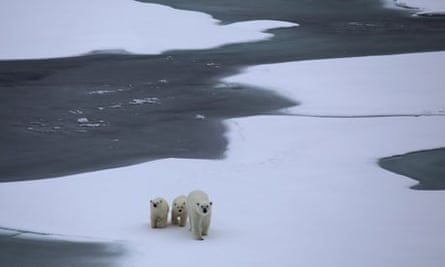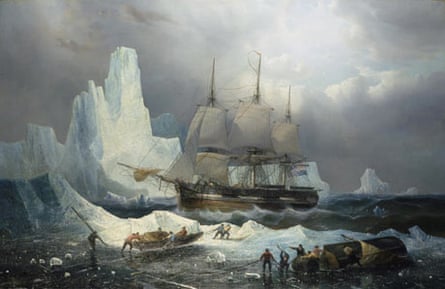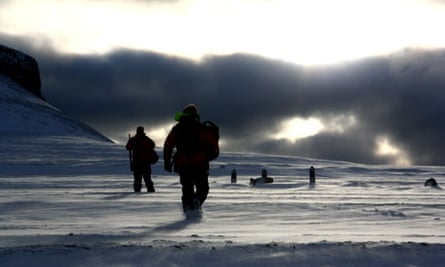"Remember, this is an expedition, not a cruise," declares our leader Boris Wise.
Projected on the wall behind him are a series of maps of the maze of islands of the Canadian Far North. These aren't just any maps though; these are real-time satellite charts, specifically detailing the extent and density of sea ice in the area. For the past five days they have been the focus of intense scrutiny.
We are hoping to navigate, from east to west, the Northwest Passage – the sea route between the Atlantic and Pacific oceans along the north coast of North America explored from the 15th century as a trading route with Asia. Once attempted only by experienced polar explorers, the journey is now being offered by small, select expedition cruise ships and a few modern mariners. This is a very special trip. Although I have been to the Arctic several times, I will be visiting areas I have never been to before.
As we soon discover, there is no guarantee of success on this traverse. The ice-choked waters of this part of the Arctic change constantly with the currents, winds and ice melt. Some years the Northwest Passage can be virtually ice-free; at other times even icebreakers can't get through. In March this year, spring temperatures plummeted to -40ºC, creating new large pans of thick sea ice, and these are now blocking our path.
Our home for this 12-day trip with One Ocean Expeditions is the Russian research vessel Akademik Ioffe. A veteran of polar conditions, the Ioffe takes adventurous passengers on specialist cruises to the Arctic and Antarctic as well as operating as a floating scientific base. It is an ice-strengthened ship, not an icebreaker, and we soon discover that we cannot achieve our goal without assistance.
As Boris cycles through the charts, swirls of bright colour expand and contract, each colour on the screen representing the ever-changing coverage and density of ice. Green denotes stretches that could be navigable by a small boat, those in yellow and orange could be crossed with an ice-strengthened vessel, and red indicates areas of thick ice that can be penetrated only by an icebreaker. It's like watching clouds form and disperse.
Our first choice of route, Peel Sound, between Prince of Wales and Somerset Island, is blocked by a swath of red. The narrow "key" to the Northwest Passage, the Bellot Strait, between Somerset and the Boothia peninsula, the northernmost point of mainland Canada, also looks impassable, with its western exit plugged by ice. Fast tidal currents run through the strait, carrying large icebergs. If we don't pick the right moment, it will be like driving down a narrow one-way street, crashing headlong into juggernauts rushing in the other direction.

Our voyage began in Kangerlussuaq, western Greenland. From there we headed north to the modern town of Sisimiut and then on to Ilulissat, home to the largest and fastest-calving glacier in the northern hemisphere. The 40km-long Icefjord sends an astonishing 20m tonnes of ice a day into the frigid waters of Disko Bay.
A wooden walkway snakes up from the town towards the fjord, raised up over boggy tundra. "Extreme Danger!" a sign along the path announces: "Risk of sudden tsunami waves, caused by calving icebergs. Death or serious injury might occur."
The spectacular fjord is worth the risk. An icescape extends as far as the eye can see. Today a gargantuan berg, tens of stories high, is lodged in the fjord, blocking the channel. On my other visits here, icebergs the size of St Paul's cathedral have drifted past, doing slow pirouettes.
Later, with Canadian and Nunavut (the newly named territory of northern Canada) flags flying, we head west across the Davis Strait, then north towards Pond Inlet, at the top of Baffin Island, where we're surrounded by humpbacks and pilot whales as a storm builds. Then we meet the ice, and the bears. In total we encounter around 25 bears on the voyage: some turn tail, but others are more curious, including a mother and two cubs who stroll towards us over floating pans of ice to within a few metres of the ship.
We cruise in zodiac inflatables to remote bird colonies, and yet more bears appear. We skirt the southern edge of Bylot Island then head north towards Devon Island. A Royal Canadian Mounted Police outpost was established in 1924 here at Dundas Harbour, marking Canada's early efforts to wrestle with sovereignty in this part of the far north. The men chose a stunning spot overlooking the entrance to Lancaster Sound. In Inuktitut this place is called Talluruti, which means 'a woman's chin with tattoos on it' – referring to the crevasses that cover Devon Island's shoreline in dark streaks.
The outpost has been abandoned: it's too difficult to sustain human life here. The wind and weather have beaten down the doors and windows of the small huts, but mementoes of the men's time here survive – a chest of drawers with its paint peeling, a sewing machine on a window sill, empty bottles of Hudson's Bay Scotch Whisky, a copy of a Jeeves and Wooster novel on a folding chair. Two years of this solitude was too much for one of the men: he committed suicide shortly before he was due to be picked up.

Although there are no humans here there is plenty of wildlife – as we land a polar bear disappears over the hills behind us. We see a peregrine falcon and an enormous, brilliant white arctic hare. Nearby are the remains of other dwellings: those of the earliest Thule Inuit, who reached this area 1,000 years ago, before they continued their great migration toward northern Greenland. Built from rocks and turf, the homes would have looked like permanent igloos, with roofs created from whale jawbones, covered with skins and turf. Our Inuit guide, Atuat, toes some scat and tells us a large herd of muskoxen were here just last week.
The highlight of the voyage is Beechey Island, off the south-west of Devon Island. I was last here some 20 years ago, and remember finding it a desolate, eerie place. Today couldn't be more different, with a fresh covering of snow, and sunlight piercing bruised clouds. On this tiny islet the first signs of an ill-fated Victorian search for the Northwest Passage were discovered.
In May 1845 two ships, the Erebus and the Terror, newly fitted with steam engines, set sail from London to cheers from a huge crowd. It was Britain's most significant Northwest Passage expedition to date, led by seasoned explorer Sir John Franklin. The ships were last seen by whalers as they headed north into Baffin's Bay. Franklin and his 128-strong crew were never seen again.
In 1850, the remains of one of Franklin's camps was discovered. Strewn over the desolate beach was an assortment of relics, and nearby three graves marked by simple headboards.
We gather at Beechey Island, as my polar historian husband Huw Lewis-Jones leads a service of reflection for Franklin and his men. As snow blows across the graves, we lift our cups of whisky and toast those that have gone before us, knowing that however much difficulty we get into on this voyage, we will surely return home.
We rendezvous with a Canadian Coastguard icebreaker the Henry Larsen and follow in her wake as she bites through the ice ahead of us. "Bear!" someone shouts, pointing to a lone bear standing on the ice. We can't stop: if we fall behind, the ice could close in around us.
We enter Bellot Strait with both engines running in case one fails in this notoriously difficult channel. Musk oxen watch us with steady eyes as we motor pass Zenith Point, the most northerly tip of the North American mainland. A white line appears on the horizon at the western end of the strait. Ice. The Larsen's helicopter is launched, scouting the conditions.

After we've trailed the icebreaker for some 20 hours, conditions improve and we squeeze into open water. With a blast from the foghorn the Henry Larsen heads north, back into the pack.
As we near King William Island the wind picks up. It is here that Franklin's Erebus and Terror were beset by ice for 19 months before being abandoned, and here that Sir John Franklin died, his body lowered beneath the ice.
Victory Point on its north-west coast, appears ahead of us illuminated in golden light. Franklin's men erected a cairn here and within it placed a record of their demise. It was the only written evidence discovered by later searches:"28 May 1847… All well". The following year the note was revised. A new message, scribbled in the margin reads: "Sir John Franklin died on 11 June 1847 and the total loss by deaths in the expedition has been to this date 9 officers and 15 men." In the years to follow, more gruesome discoveries were made, including items that suggested that some of the men had resorted to cannibalism.
King William Island is still a source of fascination for those interested in the Franklin mystery. This year another Canadian government expedition will try, using state-of-the-art sounding and imaging equipment, to discover the two lost ships.
With ice threatening to press in on us, strong currents, and winds reaching gale force, we stand on the tilting deck and look across to the low beach of this historic site. We are thankful that we are not marooned here.
It has been a spectacular journey. We have seen whales, bears, birdlife, natural phenomena, and more: we have lived through the history of human exploration here, in the most poignant way. Our trip proves to us that even with our excellent onboard staff, daily ice charts, satellite communications and icebreaker support, navigating the Northwest Passage is still an unforgettable challenge.

Comments (…)
Sign in or create your Guardian account to join the discussion